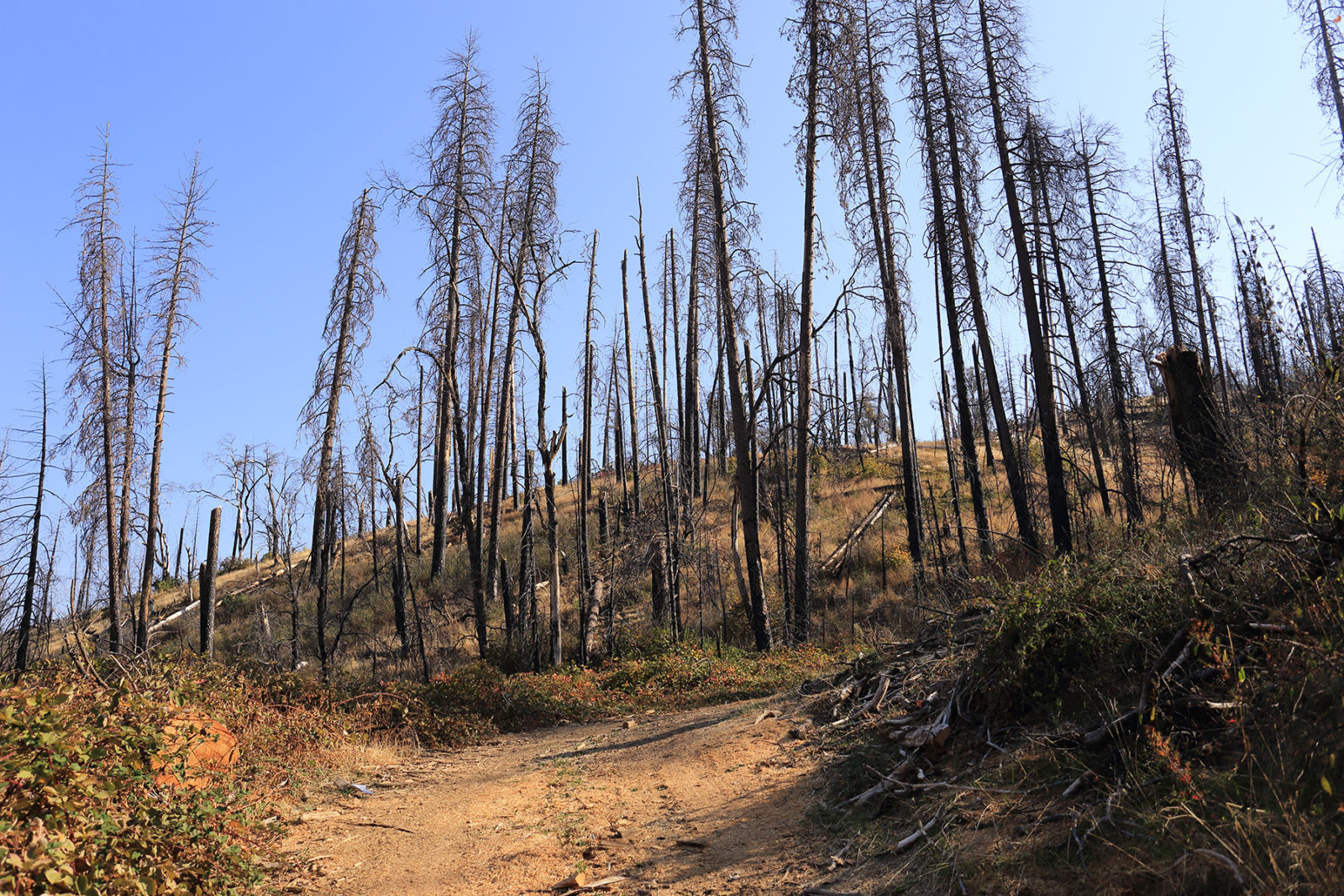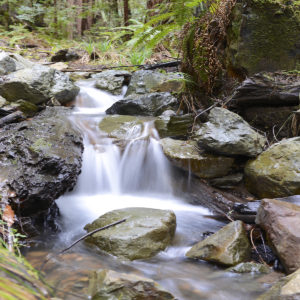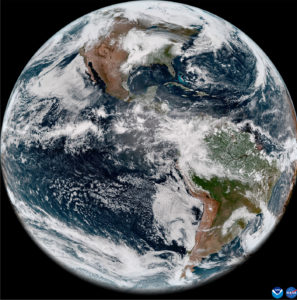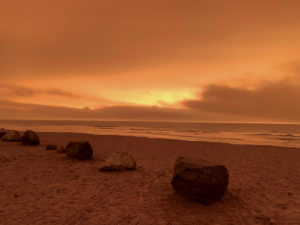On an unseasonably warm November day in a rural neighborhood in the western Sierra Nevada, men with chainsaws patrol a tree thicket that burned three years ago. One man, whose chaps have torn on his right thigh and whose shirt is stained with ash, squints at a dead pine through mesh goggles. He is surrounded by burned and blackened trees; some lean dangerously close to a powerline along a dirt road next to a home. The trees are rotten, and they could drop limbs or fall at whim. He picks up his chainsaw, makes a shallow slice in the tree, then hammers a wedge in the cut before he pushes the tree down the side of the slope. It rolls with a crash into a pile. He adjusts his gloves and looks for the next tree. And the next, and the next. In a week, the crew has felled dozens of trees and made piles like a game of giant pick up sticks alongside the white, two-story house.
This home sits in the center of the most intense path carved by the 2015 Butte Fire, but it is one of the few that has received forest restoration work. The fire scorched 71,000 acres across Calaveras and Amador counties, in the northern Sierra Nevada mountains, destroying nearly 1,000 structures and killing two people. Now three years later, residents who live nearby slowly deal with the fire’s effects, both ecological and social. “A good portion of the county burned,” long-time resident and former County Supervisor Steve Wilensky said to me during a recent visit to Calaveras. “It’s been a terrible disruption economically, with a huge diaspora of young people. It was devastating.”
In Wilensky’s view, the Butte Fire demonstrated that local participation would be the best way to abate wildfire threats. That’s also his business. In 2004, Wilensky founded Calaveras Healthy Impact Products Solutions (CHIPS), a one of its kind non-profit that provides forestry jobs for people who live in the fire-prone Sierra Nevada foothills. Notably, of the 42 locals employed by CHIPS, 33 are members of indigenous Sierra Nevada tribes, such as the Washoe and Miwok. At first, CHIPS crews mostly pruned trees and did clean-up jobs on private property. But since Butte, they have galvanized around wildfire prevention projects, specifically forest thinning and mastication – turning trees and shrubs into chips – as well as meadow restoration and prescribed burning.
For millennia, Sierra Nevada forests were maintained by naturally occurring low-to-moderate severity fires. But during the 20th century, fire was uniformly suppressed. In response, the forests have become unnaturally dense and, with fuel build-up, more flammable and prone to massive, uncontrollable fires, like Butte, or like the Camp Fire, the state’s deadliest, which raged 150 miles north of Calaveras in 2018. Scientists expect a large portion of the Sierra will burn this century as climatic conditions become more conducive to fire — that is, drier and hotter. For CHIPS, climate change propels their work: it provides crews both with tasks for the foreseeable future and the sobering incentive to do them.
Yet, the forests are only one dilemma facing the Sierra. Wilensky contends that people who live here, particularly tribal populations, have been overlooked and underemployed for too long. Calaveras faces high rates of poverty, unemployment, and methamphetamine use. The timber industry, already in decline since the 1970s, faded entirely during the 2008 recession. Calaveras experienced a contraction of economic possibility, and hope. Don Landreth, a Calaveras resident and retired logger who spent 45 years in the industry, described this view to the Calaveras Enterprise in 2006: “The logging industry started phasing out,” Landreth said, “and nothing came in.”
That’s why Wilensky says he first created CHIPS, to embark on an enterprise more radical than economic revitalization. CHIPS is a breakthrough in employment opportunities and a tangible way for locals to confront climate change. But it is also a vehicle for repairing long-standing social damage through Native-led crews.
According to Irvin Jim, the chairman of the Hung A Lel Ti Band of the Washoe Tribe, Native participation in CHIPS took time. “I was at a tribal council meeting in 2014, and someone mentioned CHIPS’ work on cultural site protection at the Mokelumne River headwaters. That got my attention because I’ve been a cultural monitor since 1998. It made me mad,” Jim said. “Why is somebody else coming in and protecting our cultural sites? That’s in our ancestral footprint. We should be doing that. So I looked into it and that’s when I first met Steve and then we started the CHIPS Native crew. It’s awesome for the crews to be back in our homelands trying to maintain them. The crews have a sense of pride in helping our ancestral lake. It’s a big thing.”
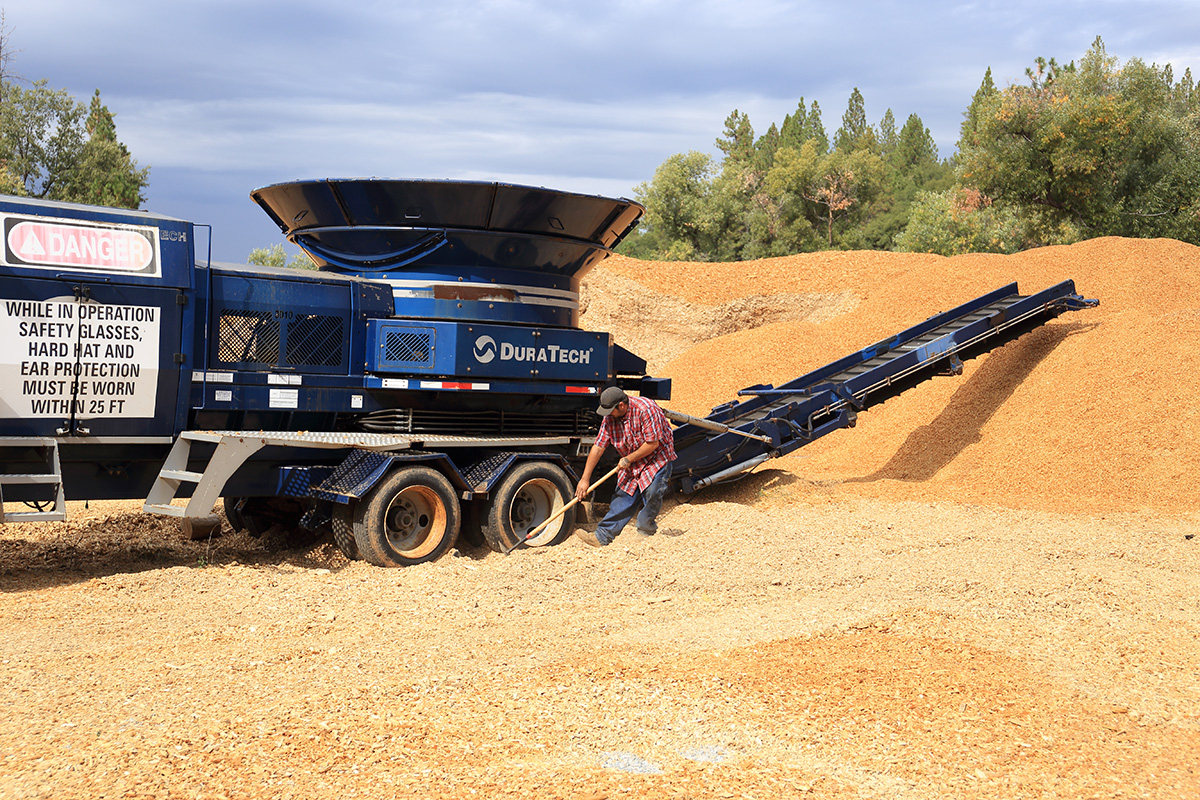
When Wilensky was in his early twenties, he quit a promising law career, put all his possessions in a backpack, and joined the United Farm Workers of America. During thirty years as a union mediator and organizer, he found purpose in resolving conflicts among bitter litigants. Wilensky also fostered an interest in farming, first with an urban farm in east Oakland. In 1986, he left to start an apple and stone fruit farm in Glencoe, bringing his family to the Sierra foothills. Wilensky’s background as a union mediator honed his skills in arbitration, but his entry into Glencoe’s local politics revealed an uncanny ability to create consensus.
In 2004, the same year he formed CHIPS, Wilensky ran for supervisor of Calaveras County. He faced David Studley, a local lawyer with endorsements from the sheriff and the incumbent supervisor, Paul Stein, who co-chaired Studley’s campaign. Stein said Studley would “uphold the conservative approach to government [my] constituents have come to expect.” Wilensky, however, became known for progressive exploits. He publicly supported the county’s first gay marriage even though the auditor and clerk refused to sign the paperwork. Wilensky’s approach connected with voters. “I was just being myself, and people thought that was weird and refreshing,” he says, recounting the events to me. On election day, Wilensky defeated Studley by 16 points. Four years later, he won again, 70-30.
In March 2005, during Wilensky’s first term, lumber mill advocates descended upon an official board meeting. According to the board’s meeting minutes, Steve Sias, a representative from the Lumber and Sawmill Workers Local Union No. 2652, told Wilensky that Calaveras residents faced layoffs from Sierra Pacific Industries and asked for assistance in retaining those jobs. Melinda Fleming, a Tuolumne resident, added her support. “The public does not understand the part the mills play in having a healthy forest,” Fleming said, according to the minutes.
“You can’t underestimate just how many challenges and existential threats we faced for the first five or six years.”
Wilensky had a different idea. He didn’t think the mills were coming back, but maybe the jobs could. He convinced a critical mass of local leaders that forestry jobs, through CHIPS, would lift Calaveras from the latest bust in a 150-year-long boom-bust cycle. He knew the transition from an extractive to a sustainable economy would be challenging. Newly hired CHIPS employees needed training and expensive forestry equipment if they hoped to compete with out-of-state crews. Although CHIPS had start-up grants, members of the board, including Wilensky, had to take money from their own retirement funds when the money ran out. “You can’t underestimate just how many challenges and existential threats we faced for the first five or six years,” Wilensky says.
Wilensky and the board hung on, but they still lacked multi-year agreements from the state that would stabilize their business model. At the same time, some CHIPS employees had become re-addicted to methamphetamines, violated their probation, or were put off by the intense physical labor demanded by the job. CHIPS crews lacked the experience of other forestry crews, like those that secured the clean-up work after the Butte Fire. “We watched people getting the big contracts come in from New Jersey, Florida,” Wilensky says.
Wilensky redoubled his efforts to recruit employees who would commit to staying clean and working for CHIPS year-round. Wilensky also credits “rebel leaders” within the United States Forest Service (USFS) who, before CHIPS was a known entity, gave the non-profit a small contract. Wilensky’s tactics, and a lucky first break, at last produced success. CHIPS crews started winning multi-year contracts from the USFS for work in El Dorado National Forest, Yosemite National Forest, numerous county projects, and private property restoration. Today, the crews earn enough income to cover staff pay and equipment – a unique transition for a non-profit that formerly survived on grants – and the CHIPS board is currently developing a benefits system. “Getting a workforce back on its feet was no small task,” he says to me, “but we proved our worth and mettle.”
Since Wilensky’s term as supervisor ended in 2012, he has been devoted to the expansion and evolution of CHIPS projects. Forest restoration, not merely clean-up, is at the forefront. Case in point, Wilensky has taken to calling CHIPS crews the stewards of the “Range of Light” – John Muir’s term for the Sierra. That ambition has blossomed in the form of an ongoing CHIPS project along scenic Highway 88. The road, which begins at the Nevada border, crosses Carson Pass south of Tahoe, and ends in Stockton. It is the original path of American settlers in the 1840s. In 2015, the Butte Fire jumped Highway 88 in its path of destruction.
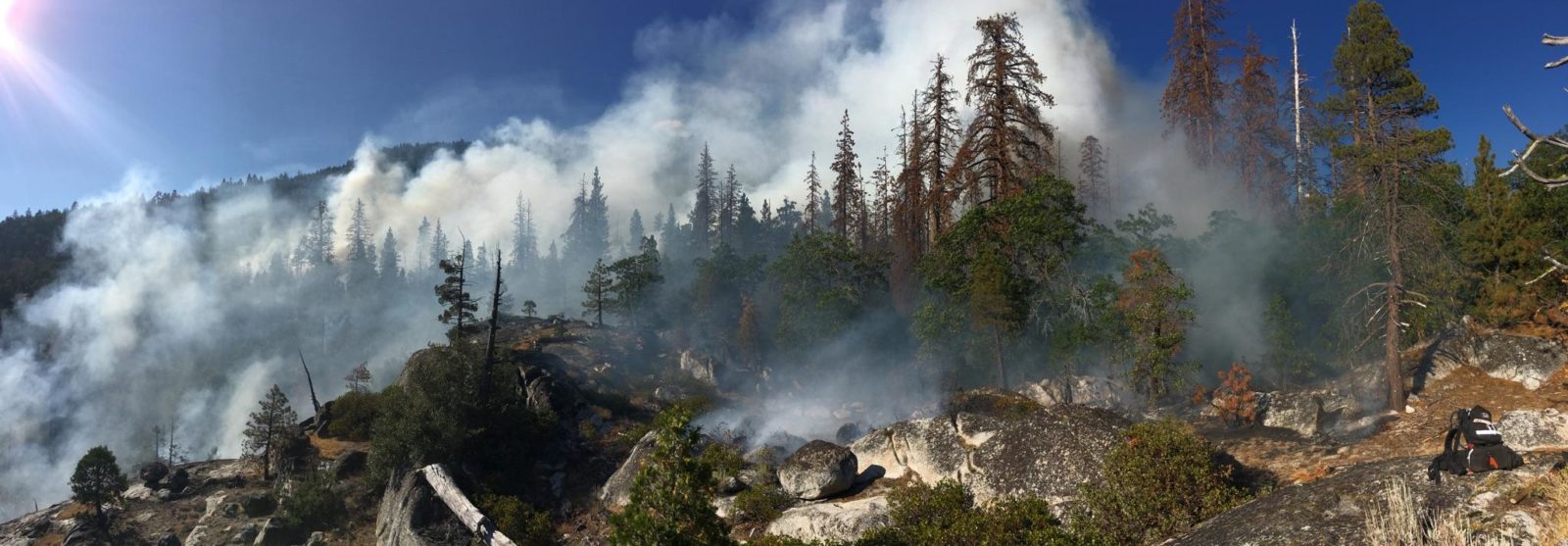
Highway 88 is still a key route into the mountains, and I saw it for first time last October as I drove Wilensky westward. He was taking me on a tour of CHIPS’ projects, starting with Highway 88. Steeply graded, the highway twists along a ridge and is framed by a dark green and sweet-smelling conifer forest. CHIPS’ goal is to turn the road into a 20-mile fuel break – management lingo for strips of low-density forest used by firefighters to gain access to, and then control over, a fire. In practical terms, the fuel break declutters the forest along the road’s edge. With enough space between trees, fire cannot spread from one side to the other.
We spot CHIPS vehicles parked in turnouts, the day’s work well underway. The crews have cut tree limbs and gathered the woody castoffs into enormous heaps, up to five-by-five feet wide. The piles line the road side like lumpy mileposts. As we cruise past, Wilensky exclaims, “Look at all these!” He pauses, then adds: “I’m very proud of this.”
“We’re serious. We have a good scientific basis to what we’re doing. … There’s a lot of hope that we can get a handle on this, at least in this neighborhood.”
The drive along Highway 88 with Wilensky offers a new view of the landscape, as if it were under an ultraviolet light. Where I notice individual pines and firs and tree debris, he sees a landscape revived by the principles of sustainable forest management. Wilensky points to the largest trees. The crews leave those alone, he explains, because their thick bark resists fire, and they store more carbon than small trees. CHIPS crews aim to restore variability in species and tree size – a kind of forest mosaic – because it reflects the mixed-conifer forest that settlers would have encountered and that the Washoe lived in for millennia. “We’re serious. We have a good scientific basis to what we’re doing,” Wilensky says. Come winter, the piles will be burned, and the dangerous fuels cleared out. “There’s a lot of hope that we can get a handle on this, at least in this neighborhood.”
Such initiatives, though seemingly at the neighborhood scale, in fact protect large areas, especially those downstream. When catastrophic wildfires like the Butte Fire burn, the debris can find its way into rivers where it becomes toxic runoff. Highway 88 isn’t far from the Mokelumne River headwaters, a watershed that supplies water to 1.3 million residents of the San Francisco Bay Area. “[Bay Area residents] should view their own fate as intertwined with ours,” Wilensky says.
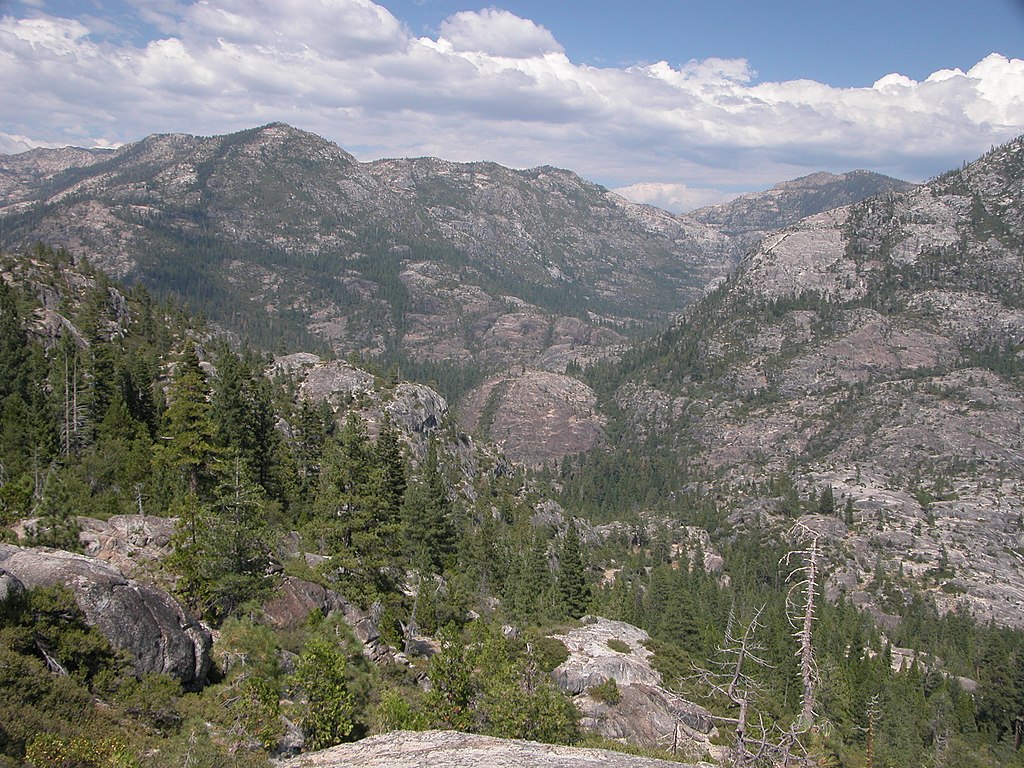
I lift my foot off the gas pedal and let gravity tug us downhill. Water glimmers in the foreground. It’s our destination: Silver Lake. In the parking lot, three Washoe men wait for us. They form part of an all Native CHIPS crew that works around Lake Tahoe, their ancestral lands. Members of the Miwok and Paiute tribes are also represented at CHIPS. CHIPS’ use of Native crews is also a recognition that indigenous land management had succeeded long before the principles were validated by mainstream channels. “We employ a lot of people,” Wilensky says, “including the truly righteous deployment of Native people to go back to do the things they’ve been doing for 10,000 years to good avail.” As I pull up alongside the native crew’s blue pick-up truck, I spy a bumper sticker: Keep Tahoe Washoe.
As a trio, Greg Bennett, Sam Simmons, and Irvin Jim represent a gradation of age. Bennett, a tribal elder, has two long neat braids held back by a faded bandana. He worked on hotshot fire crews from the age of 17 and is now near retirement. Simmons, who wears a snapback Warriors hat and is the youngest of the trio, joined the crew three and a half years ago. Jim, the Tribe’s Chairman, appreciates the views of both generations and their contributions to CHIPS.
Simmons was one of the first to join a Native crew. “When we started we didn’t know what we were getting ourselves into. We ended up staying at Steve’s house and working with other CHIPS members there,” Simmons says. “We learned so much in these last three years working with CHIPS – learning how to cut line, reduce fuels, and clear the meadows.” Simmons and his crew used these skills to restore Spooner Summit along Lake Tahoe’s eastern side. In 2018, the Native crew won a “Best of Tahoe” award from the Lake Tahoe Basin Management Unit.
We settle at a wooden table that overlooks the lake, under a sky that has darkened considerably, and they describe the practices of their ancestors. For thousands of years, the tribe fished during the summer months at Lake Tahoe, the spiritual and geographical center of their territory, which back then encompassed thousands of square miles in what is now California and Nevada. Then, before the winter storms came and they headed south, the Washoe would start fires in the open, park-like forests. The forest’s openness meant that fires would stay small and burn at a low-intensity – perfect for clearing brush and leaving larger trees unharmed. “When they came back the next summer, it’d be green again,” Jim explains.
But everything changed after European settlers arrived in the nineteenth century. The federal government’s policy of fire suppression arrested the natural fire regime under which the forests had evolved. As fuels built up in the forest, the fires became larger and more intense, a mistake that haunts public lands to this day. “That’s why California is burning up,” Bennett says. Jim, nodding at Bennett, says, “Their practices don’t work.” Jim gestures to the knotty grove of pines across the road: “They just let it grow like this.”
[Bay Area residents] are so used to the city life and everything being right there. They don’t realize that their fresh water comes from areas like this. And it has to be healthy in order to sustain us, to keep us going. They don’t have respect for anything, sorry to say.”
The government approached tribes with the same attitude it took toward fire: systematic eradication. The Washoe and other local tribes that survived were moved to reservations. Their ancestral lands shrunk considerably, along with their heritage. Jim, Bennett, and Simmons agree that the full extent of the damage isn’t well-known outside their communities. “There’s no education about us,” Bennett says. “Nothing is taught in the grammar schools about Indians, not the real history anyway.”
Wilensky believes ignorance of tribal history is intertwined with the urban-rural divide. “It’s not just Native American folks, it’s rural people in general,” Wilensky says. “They’ve had their forests and watersheds pillaged and looted.” He, along with Jim, cites the flow of water from the Mokelumne River to supply Bay Area residents as one example of an unjust status quo. Jim believes that downstream water users are unaware of the water’s origin and the watershed’s stewardship needs. “They [Bay Area residents] are so used to the city life and everything being right there,” Jim says. “They don’t realize that their fresh water comes from areas like this. And it has to be healthy in order to sustain us, to keep us going. They don’t have respect for anything, sorry to say.”
Wilensky, drawing on his past as a union mediator, has a plan to ease rural-on-urban resentment: a new fiscal arrangement. Wilensky estimates the Mokelumne watershed requires $5-6 million per year for restoration and maintenance, and he would like to see annual compensation from Bay Area users to help with those costs. According to the East Bay Municipal Utility District, most East Bay customers pay two cents per gallon for water. Although the district budgeted $16 million in 2019 for management of its 58,000 acres of watershed lands in the East Bay and Sierra foothills, Wilensky argues his watershed needs its own fund. “Why not 10 cents per month per person to a direct trust for Sierra stewardship?” he says, an amount which would generate what he sees as a proportional contribution of $1.7 to 1.8 million per year from East Bay residents.
To date, funding for forest management that safeguards the watershed has largely come from statewide ballot measures. Proposition 84 and Proposition 1 – passed in 2006 and 2014, respectively – have financed $79 million in grants for fuels reduction and watershed and forest restoration efforts throughout the Sierra. Both, however, were opposed by Calaveras County residents and passed on the strength of support in urban areas. Wilensky is aware of the contradiction. “At the time of those ballot measures, unemployment was around 24 percent. People voted their anger to some extent,” he says. But, he notes, “They [urban people] should stop complaining about how we vote and help us out. They’ll find changes in our electoral patterns after, but not before, a partnership is effectuated.”
It’s a bullish strategy, but has, Wilensky insists, produced results. “People are starting to see a connection with their vote to work on the ground. Funding is in the pipeline and people are getting jobs. This district was a hard-right voting bloc but has elected progressive county supervisors in the last four elections,” he says. CHIPS, for its part, has created stable employment in restoration and stewardship. And as blue collar jobs change not just in Calaveras but across the country, Calaveras’ tactic shows promise as a model for economic transitions elsewhere. “We are a microcosm of how change can happen in rural places,” Wilensky says.

Wilensky’s efforts have inspired other locals, like Pat McGreevy, to take part in the restoration, bringing CHIPS closer to the last stage of Wilensky’s vision for a sustainable operation: building a cogeneration plant. A cogeneration plant, which uses a single fuel source, such as biomass, to produce two or more forms of energy, could be powered with biomass product from CHIPS’ operation. In 2010, after learning about the cogeneration plant and CHIPS from Wilensky, McGreevy decided to volunteer his time, up to 60 hours a week. McGreevy is a retired Army lieutenant colonel and tropical disease scientist; he conducted research on malaria, leishmaniasis, and schistosomiasis in Brazil while affiliated with the Walter Reed Army Institute of Research. McGreevy has brought scientific sophistication and considerable proposal writing skills to the effort. “Everyone laughed [at first], but today we’re getting million dollar grants from the state to get this done,” McGreevy says as we stand on a dirt path on a recent outing to see CHIPS’ newest effort.
McGreevy leads a CHIPS mastication project that will turn unwanted trees and shrubs into mulch for use in the cogeneration plant. Today he is showing me a 912-acre piece of BLM land that is both landlocked by private homes and hidden by impenetrable six-foot manzanita. In Calaveras and much of the West, BLM property is intermingled with private holdings. But because the federal government is responsible for so much land – over 50 percent of the Sierra Nevada – and money is often tight, small parcels like this one often receive no attention. McGreevy, however, secured funds for the site’s mastication, which will remove much of the dangerous fuels that threaten the nearby homes. “I’m really wound up about this,” McGreevy says. He looks warily at the dense manzanita. “We’ll be back to where we started if we don’t do anything. We’re waiting for Butte 2.0.”
Like Wilensky, McGreevy pursues preventative action with the air of a man being hunted, but as a scientist, he waits to be convinced by the evidence. “People want to blame PG&E for the Butte Fire but I see it differently,” McGreevy says. Indeed, Calaveras residents held PG&E responsible for the 2015 fire, and settled with the utility for $25 million in mid-November 2018 after a CAL-Fire investigation found that a PG&E power line touched brush and sparked the flames. Other recent fire starts have been unpredictable. The Ranch fire, which merged with the nearby River fire to become the Mendocino Complex fire, was started by a hammer spark, while the Carr fire ignited from sparks coming off a tire’s steel rim. McGreevy believes fire danger can be minimized. Fire has two parts, he explains, ignition and spread. Ignition sources like lightning and powerlines are largely unavoidable, but the fire can be stifled if fuels are removed.
Some of my neighbors say, ‘Oh, there’s nothing we can do, that’s the way it is.’ But we don’t have to live in fear if we roll up our sleeves, use our brains, and utilize state assistance.”
To demonstrate, McGreevy unfurls a map across the back of his green Subaru. It displays the county’s ridgelines with marks where strategic fuel breaks should be placed to limit the spread of the next wildfire. Soon, McGreevy will submit a grant for more fuel treatments in order to expand CHIPS’ projects beyond Wilensky’s Highway 88 project. “Some of my neighbors say, ‘Oh, there’s nothing we can do, that’s the way it is,’” McGreevy says. “But we don’t have to live in fear if we roll up our sleeves, use our brains, and utilize state assistance.”
Those at the state level agree. Helge Eng, an expert in forest operations and deputy director of resource management at Cal Fire, works to expand Cal Fire’s capacity and implementation of large-scale forest projects. “It’s impossible to predict [where] wildfire [will take place], so we have to be ready for the whole state,” Eng says. Statewide preparation will be difficult, Eng concedes, because large trained groups must be marshaled in order to solve on-the-ground climate change problems. Wilensky, heeding the call, has already secured Cal Fire funding for a prescribed burning class so that CHIPS crews can cover larger areas for their restoration work.
Wilensky and Eng both see CHIPS as a model that could be applied across the state, especially if CHIPS is successful in opening its cogeneration plant. If the biomass generated from mastication projects can be converted into energy, it will close CHIPS’ operational loop. “I think CHIPS is an excellent effort,” Eng says. But ultimately, he says, what’s needed is dozens of similar programs that work in concert.
During a board meeting at CHIPS headquarters last November, Wilensky discussed the cogeneration plant. Once the plant opens, he wants to add new full-time positions for truck drivers to transport biomass to and from CHIPS sites. The meeting room is sparse but homey, with colorful handwoven quilts displayed on the walls, old desktop computers on several tables, and space heaters turned all the way up. On the wall opposite Wilensky hung a poster. It was a reminder of CHIPS’ aspiration about building community and it read, “No one is silent though many are not heard. Work to change this.” CHIPS’ tasks are mounting, and solutions require complicated justice, justly delivered. “This tiny non-profit is developing the biggest economic development project in Calaveras county in decades,” Wilensky says. “We are a body of lessons and we have a story to tell.”

